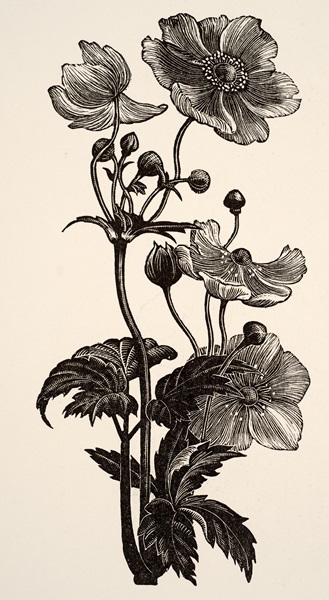My Favourite Object #5: ‘Four Hedges', a book by Clare Leighton
By Fiona Melhuish, UMASCS Librarian
The wood engravings of Clare Leighton (1898-1989) were among the most exceptional examples of the art form produced during the revival of the art of wood engraving in the 1930s. She illustrated numerous books, several of which she had also written, and wrote a manual on her craft entitled Wood-Engraving and Woodcuts, published in 1932. Leighton was born in London and studied at the Brighton College of Art and later at the Slade. In 1922 she attended classes at the Central School of Art and Design where she discovered wood-engraving under the tuition of Noel Rooke (1881-1953) who was a major influence in reviving the practice of wood engraving in the twentieth century. His students also included Robert Gibbings and Eric Gill. Through Rooke’s classes, Leighton discovered a career in which ‘head, heart and hand might join’ in the words of her poet grandfather. Her engravings have a very powerful sculptural and monumental quality and are very recognisable. The natural world and rural people and their working lives were key themes in Leighton’s work. Along with her contemporary, Agnes Miller Parker, Leighton played a part in raising the popularity of wood-engraved book illustration on rural life and the natural world and improving aesthetic standards in popular book illustration.

The Farmer’s Year : a calendar of English husbandry (1933) is considered as her finest work, with its strong, almost bleak, images of rural workers, and her own text which showed a keen understanding and sympathy for life in the countryside, nurtured by her travels in Europe. However, my favourite book by Leighton is her later publication, Four Hedges. Published by Victor Gollancz in 1935, it was both written and illustrated by Leighton and became one of her bestsellers. Leighton stated in a letter to her publisher that “I want to keep the balance between the flowers and plants themselves (for this isn’t to be a professional gardening book, but only a year in an ordinary garden), the living things in the garden and the effect of the garden upon me, too, as a living thing.”

The book is divided into monthly sections, with striking and exquisitely rendered engravings of flowers, fruits, birds and animals, many drawn in her own garden in the Chilterns, to accompany her commentary. The text is a personal and anecdotal celebration of Leighton’s enjoyment of nature and of her garden which she had created from a Buckinghamshire meadow, with observations such as “I mow the lawn. How many people know the right way it should be done? Feet should be bare; grass should be slightly damp. The cold, moist clover strikes up from the mower upon my bare feet, and blades of cut grass and bits of slashed weeds stick between my toes”.
One of my favourite engravings from Four Hedges is her illustration of two women gathering apples in the ‘September’ chapter [see image below]. As with many of Leighton’s illustrations, it has a beautiful composition and strength of form. As the writer Joanna Selborne observes, “[the] figures are monumental and rhythmic, as epitomised by the swinging body of the apple gatherer”.

Other works and items relating to Clare Leighton held by the University of Reading Special Collections and the library of the Museum of English Rural Life include two copies of The farmer’s year, a copy of Leighton’s manual, Wood-engraving and woodcuts, and a proof-pull print entitled The quay held in the Miscellaneous Prints Collection. All of these items can be viewed at the Special Collections Service reading room on request. A further two publications Country Matters (1937), a collection of essays on country people and their occupations, written as “a record of an enduring world” and a catalogue for an exhibition of Clare Leighton’s work at the Ashmolean Museum in 1992 have been ordered to add to our holdings of material relating to this gifted artist.
References and further reading
Clare Leighton. The farmer’s year : a calendar of English husbandry, written and engraved by Clare Leighton.
London : Collins, 1933. Two copies are held at MERL LIBRARY RESERVE FOLIO–9390-LEI
Clare Leighton. Four hedges : a gardener’s chronicle, written and engraved by Clare Leighton. London : Victor Gollancz Limited, 1935. A copy is held at PRINTING COLLECTION–635.09422-LEI
Clare Leighton. Wood-engraving and woodcuts. London : The Studio, 1944. A reference copy is held in the Mark Longman Library at the Special Collections Service at MARK LONGMAN LIBRARY–761.2-LEI
Joanna Selborne. British wood-engraved book illustration, 1904-1940 : a break with tradition. Oxford : Clarendon, 1997. A copy is held at SPECIAL COLLECTIONS REFERENCE–769.9420904-SEL and a loan copy is held on the 3rd floor of the University of Reading Library at FOLIO–769.942-SEL
University of Reading Rural History Centre. The art of the country : farm work and country life through artists’ eyes: an exhibition of pictures on loan from a private collection. Reading : University of Reading, Rural History Centre, 1996. A copy is held at MERL LIBRARY PAMPH BOX–9390-UNI 29754

Many thanks to David Leighton for his kind permission to reproduce some of the illustrations from Four Hedges.
